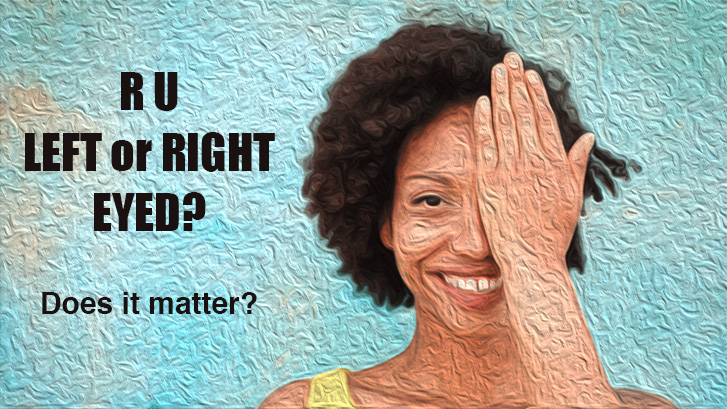
This test will hopefully demonstrate which eye - left or right - is functioning at a higher level when you are reading or trying to interpret many shapes.

Look at the center of the animation and try to read the text that flashes on the left and right side of the screen. Which side did you read quicker?

As reported in Science Daily -- A person has two hands, two legs, two eyes, two cerebral hemispheres. But it is only at first sight that a human being is a symmetric creature. Firstly, we have a leading hand, the right one with the majority of people, secondly, we have a leading eye. Thirdly, the brain is functionally asymmetric: the left hemisphere (with the right-handers) is mainly connected with abstract-logical thinking and to a larger extent -- with speech, the right hemisphere -- with image sensitivity.
Coming back to eyes, the right eye is the leading one among the two thirds of people, and the left one among one third of people. Special tests have been developed to determine this. Do these individual differences influence the visual information perception process, for example, perception of texts, on the left and on the right? Investigations carried out at the Institute of Cognitive Neurology of the Modern University for the Humanities will help to answer this question.
The experiment involved all right-handed students, but some of them had the right eye leading, the others – the left eye leading. All probationers were offered to read a text on the PC screen, the text being placed either in the right or in the left part of the screen, while the probationers' head was oriented to the center (in such conditions, visual information from the left half-field of vision was addressed to the right hemisphere, and vice versa). It has turned out that the "left-eyed" probationers read the text quicker when it is placed on the left, than the text placed on the right. As for the "right-eyed" individuals, no such differences were noticed with them.
More detailed analysis has proved that when the "left-eyed" probationers were reading the left-side text, the brain perceived (during a single eye fixation on some text fragment) more symbols than in case of reading the right-hand text.
In other words, in the left half-field of vision, glance fixation is characterized by higher "information capacity". This is directly connected with the speed of reading: the more symbols the glance perceives during one fixation, the quicker a person reads. There is one more sign of successfulness of reading: in the course of reading, the glance periodically returns back to the already read word (apparently due to difficulty of perception). Thus, in the left-sided text, the "left-eyed" probationers made less returns than they did in the right-sided text, which means higher successfulness of the "left" text recognition. Besides, the majority of the "left-eyed" persons performed faster quick eye movements -- saccades -- to the left than to the right.
Physiologists can only make assumptions about the reasons for such differences.
As all the probationers are right-handed persons, the control over their leading right hand is performed by the left hemisphere. With the right-eyed, the same left hemisphere also controls the leading right eye. As for the left-eyed persons, the leading left eye is controlled by the right hemisphere, which is free from control over the leading hand's movements.
And this works out better. Therefore, the "left-eyed" persons read quicker on their left.
Where can this knowledge prove useful? Apparently, it makes sense to take the leading eye into account for production of various video-products, for example, training ones. Special objects (spoons, door-handles) are produced for the left-handed, but there is nothing special made for the "left-eyed" persons. Maybe this will be done in the future.
Comments:
As a former baseball coach, I found that knowing a hitter's eye-"ness" helped determine how they should stand at the plate. A right-handed batter who is left-eyed is more effective in a closed stance (left foot closer to the plate), while a right-eyed, right-handed batter -- the majority of players, so I discovered -- improves his hitting considerably with an open stance, where the head turns more naturally toward the pitcher for a full view of the ball as it's delivered. Naturally the opposite is true for a left-handed batter.
Zac Denver
